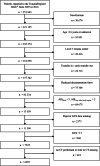The faster the better? Time to first CT scan after admission in moderate-to-severe traumatic brain injury and its association with mortality
- PMID: 33340052
- PMCID: PMC8490239
- DOI: 10.1007/s10143-020-01456-3
The faster the better? Time to first CT scan after admission in moderate-to-severe traumatic brain injury and its association with mortality
Abstract
Fast acquisition of a first computed tomography (CT) scan after traumatic brain injury (TBI) is recommended. This study is aimed at investigating whether the length of the period preceding initial CT scan influences mortality in patients with leading TBI. A retrospective cohort analysis of patients registered in the TraumaRegister DGU® was conducted including adult patients with TBI, defined as Abbreviated Injury ScaleHead ≥ 3 and GCS ≤ 13 who had been treated in level 1 or 2 trauma centers from 2007-2016. Patients were grouped according to time intervals either from trauma or from admission to CT. A total of 6904 patients met the inclusion criteria. Mean time period from trauma to hospital admission was 68.8 min. From admission to first CT, a mean of 19.0 min elapsed. Trauma severity was higher in groups with a longer duration from trauma to CT as represented by a mean (± standard deviation) Injury Severity Score (ISS) of 19.8 ± 9.0, 20.7 ± 9.3, and 21.4 ± 7.5 and similar distribution of mortality of 24.9%, 29.9%, and 36.3% in the ≤ 60-min, 61-120-min, and ≥ 121-min groups, respectively. An adjusted multivariable logistic regression model showed a significant influence of the level of the trauma center (p = 0.037) but not for interval from admission to CT (p = 0.528). TBI patients with a longer time span from trauma to first CT were more severely injured and demonstrated a worse prognosis, but received a CT scan faster when duration from admission is observed. The duration until the CT scan was obtained showed no significant impact on the mortality.
Keywords: Admission; Computed tomography; Mortality; Register; Trauma; Traumatic brain injury.
© 2020. The Author(s).
Conflict of interest statement
Rolf Lefering declares that his institution (IFOM) has an ongoing service agreement with AUC GmbH, the owner of the TraumaRegister DGU database, which includes statistical support for scientific analyses using registry data. All other authors declare that they have no conflicts of interest.
Figures




Similar articles
-
Impact of Glasgow Coma Scale score and pupil parameters on mortality rate and outcome in pediatric and adult severe traumatic brain injury: a retrospective, multicenter cohort study.J Neurosurg. 2017 Mar;126(3):760-767. doi: 10.3171/2016.1.JNS152385. Epub 2016 Apr 1. J Neurosurg. 2017. PMID: 27035177
-
Moderate and severe traumatic brain injury: effect of blood alcohol concentration on Glasgow Coma Scale score and relation to computed tomography findings.J Neurosurg. 2015 Jan;122(1):211-8. doi: 10.3171/2014.9.JNS14322. J Neurosurg. 2015. PMID: 25361494
-
The development of acute lung injury is associated with worse neurologic outcome in patients with severe traumatic brain injury.J Trauma. 2003 Jul;55(1):106-11. doi: 10.1097/01.TA.0000071620.27375.BE. J Trauma. 2003. PMID: 12855888
-
Simplifying the use of prognostic information in traumatic brain injury. Part 2: Graphical presentation of probabilities.J Neurosurg. 2018 Jun;128(6):1621-1634. doi: 10.3171/2017.12.JNS172782. Epub 2018 Apr 10. J Neurosurg. 2018. PMID: 29631517
-
Contribution of CT-Scan Analysis by Artificial Intelligence to the Clinical Care of TBI Patients.Front Neurol. 2021 Jun 10;12:666875. doi: 10.3389/fneur.2021.666875. eCollection 2021. Front Neurol. 2021. PMID: 34177773 Free PMC article. Review.
Cited by
-
Clinical Significance of the Control CT Rotterdam Score Compared With the Admission CT Rotterdam Score in Patients With Isolated Severe Traumatic Brain Injury in the Intensive Care Unit.Cureus. 2024 Sep 20;16(9):e69792. doi: 10.7759/cureus.69792. eCollection 2024 Sep. Cureus. 2024. PMID: 39429351 Free PMC article.
-
Development of a Quality Indicator Set for the Optimal Acute Management of Moderate to Severe Traumatic Brain Injury in the Australian Context.Neurocrit Care. 2025 Apr;42(2):485-494. doi: 10.1007/s12028-024-02107-x. Epub 2024 Sep 5. Neurocrit Care. 2025. PMID: 39237845 Free PMC article.
-
Early Pupillometry Assessment in Traumatic Brain Injury Patients: A Retrospective Study.Brain Sci. 2021 Dec 20;11(12):1657. doi: 10.3390/brainsci11121657. Brain Sci. 2021. PMID: 34942959 Free PMC article.
-
Development and validation of a nomogram for predicting early neurological deterioration in patients with moderate traumatic brain injury: a retrospective analysis.Front Neurol. 2025 Feb 5;16:1512125. doi: 10.3389/fneur.2025.1512125. eCollection 2025. Front Neurol. 2025. PMID: 39974365 Free PMC article.
-
Is time to first CT scan in patients with isolated severe traumatic brain injury prolonged when prehospital arterial cannulation is performed? A retrospective non-inferiority study.Scand J Trauma Resusc Emerg Med. 2024 Sep 5;32(1):81. doi: 10.1186/s13049-024-01251-9. Scand J Trauma Resusc Emerg Med. 2024. PMID: 39237957 Free PMC article.
References
-
- Brazinova A, Majdan M, Leitgeb J, Trimmel H, Mauritz W. Austrian Working Group on Improvement of Early TBI Care. Factors that may improve outcomes of early traumatic brain injury care: prospective multicenter study in Austria. Scand J Trauma Resusc Emerg Med. 2015;23:53. doi: 10.1186/s13049-015-0133-z. - DOI - PMC - PubMed
-
- DGU Weißbuch Schwerverletztenversorgung, 3. Erweiterte Auflage 2019 (Vorabdruck) https://www.dgu-online.de/fileadmin/published_content/5.Qualitaet_und_Si... [in German, accessed Mar 10 2020]
MeSH terms
LinkOut - more resources
Full Text Sources
Medical
Miscellaneous

